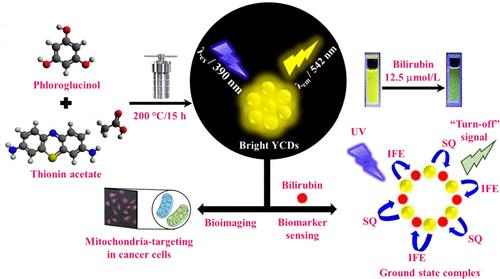Yellow Emissive Carbon Dots – A Robust Nanoprobe for Highly Sensitive Quantification of Jaundice Biomarker and Mitochondria Targeting in Cancer Cells
IF 4.6
Q2 MATERIALS SCIENCE, BIOMATERIALS
引用次数: 0
Abstract
The abnormally high level of bilirubin (BR) in biofluids (human serum and urine) indicates a high probability of jaundice and liver dysfunction. However, quantification of BR as the Jaundice biomarker is difficult due to the interference of various biomolecules in serum and urine. To address this issue, we developed a fluorescence-based detection strategy, for which yellow emissive carbon dots (YCDs) were produced from a one-step solvothermal process using phloroglucinol and thionin acetate as chemical precursors. The as-fabricated YCDs exhibited a strong fluorescence peak at the wavelength of 542 nm upon excitation at 390 nm. We used YCDs for detecting BR through the fluorescence turn-off mechanism, unveiling the excellent sensitivity in the linear range of 0.5–12.5 μM with a limit of detection (LOD) of 9.62 nM, which was far below the clinically relevant range. The analytical nanoprobe also offered excellent detection specificity for quantifying BR in real samples. Moreover, the biocompatible fluorescent nanoprobe was successfully employed to target mitochondria in live cancer cells. A colocalization study confirmed that YCDs possessed the ability to target mitochondria and overlapped completely with MitoTracker Red. The developed nanoprobe of YCDs turned out to be straightforward in their synthesis, noninvasive, and can be utilized for biomedical sensors to diagnose the onset of jaundice as well as for mitochondria targeting.

黄色发射碳点--一种用于高灵敏定量黄疸生物标记物和靶向癌细胞线粒体的耐用纳米探针
生物流体(人体血清和尿液)中胆红素(BR)含量异常高,表明黄疸和肝功能异常的可能性很大。然而,由于血清和尿液中各种生物大分子的干扰,将胆红素作为黄疸生物标志物进行定量分析十分困难。为了解决这个问题,我们开发了一种基于荧光的检测策略,即使用氯代葡萄糖醇和乙酸亚硫氨酯作为化学前体,通过一步溶热工艺制备黄色发射性碳点(YCD)。在 390 纳米波长的激发下,制备的 YCD 在 542 纳米波长处显示出强烈的荧光峰。我们利用 YCDs 通过荧光熄灭机制检测 BR,发现其在 0.5-12.5 μM 的线性范围内具有极佳的灵敏度,检测限(LOD)为 9.62 nM,远低于临床相关范围。该分析纳米探针还具有极佳的检测特异性,可定量检测真实样本中的 BR。此外,这种生物相容性荧光纳米探针还被成功地用于靶向活癌细胞中的线粒体。共定位研究证实,YCDs 具有靶向线粒体的能力,并与 MitoTracker Red 完全重叠。所开发的 YCDs 纳米探针合成简单、无创伤,可用于生物医学传感器,以诊断黄疸的发生以及线粒体靶向。
本文章由计算机程序翻译,如有差异,请以英文原文为准。
求助全文
约1分钟内获得全文
求助全文
来源期刊

ACS Applied Bio Materials
Chemistry-Chemistry (all)
CiteScore
9.40
自引率
2.10%
发文量
464
期刊介绍:
ACS Applied Bio Materials is an interdisciplinary journal publishing original research covering all aspects of biomaterials and biointerfaces including and beyond the traditional biosensing, biomedical and therapeutic applications.
The journal is devoted to reports of new and original experimental and theoretical research of an applied nature that integrates knowledge in the areas of materials, engineering, physics, bioscience, and chemistry into important bio applications. The journal is specifically interested in work that addresses the relationship between structure and function and assesses the stability and degradation of materials under relevant environmental and biological conditions.
 求助内容:
求助内容: 应助结果提醒方式:
应助结果提醒方式:


